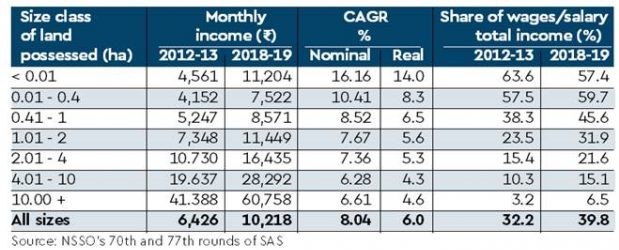Towards doubling farmers’ income
05 Jan 2022
Opinion: Tarujyoti Buragohain
The government can take surer strides towards increasing agricultural households’ income if it were to guarantee more than 100 days of work under the MGNREGA and invest more in supporting livestock farming an analysis of SAS data shows.
Prime minister Narendra Modi had made a mention of his dream to see farmers’ income double in 2022 on February 282016 while addressing a kisaan rally in Bareilly Uttar Pradesh. The Ashok Dalwai Committee made it clear that the target of doubling farmers’ incomes was in real terms and the goal was to be achieved over 7 years with the base year of 2015-16. The committee stated that a growth rate of 10.4% per annum would be required to double farmers’ income.
The NSSO released the 77th round of its Situation Assessment Survey (2018-19). Juxtaposing its findings against those of the SAS 2012-13 we see that the average agricultural household earned a monthly income of `6426 and `10218 respectively in 2012-13 and 2018-19 in nominal terms.
In nominal terms the compounded annual growth rate (CAGR) is 8.04%. When we used the GDP CPI-Al and WPI deflators to convert the income in real terms CAGRs of the real income of the farmers were found to be 4.1% 3.1% and 6% respectively. Hence we chose to use WPI to convert the nominal income to real income as this deflator has been used widely.
The NSSO estimates the farmers’ household income in seven groups based on land size holdings in hectares viz:(i) <0.01 (ii) 0.01-0.4 (iii) 0.41-1 (iv) 1.01-2 (v) 2.01-4. (vi) 4.01—10 and (vi) 10 above.The CAGRs of real incomes (deflated by WPI) are 14% 8.3% 6.5% 5.6% 5.3% 4.3% and 4.6% respectively for the <0.01 0.01-0.4 0.41-1 1.01-2 2.01-4 4.01—10 and 10 hectare and above landholding categories. As per the latest Agricultural Census India has 14.65 crore agricultural households of which 10.03 crore belong to the first three categories—this means about 68% of the farmer population consists of marginal farmers. The average CAGR of the first three categories is 9.6%.
This growth rate is very close to the recommended growth rate of 10.45. At the state level very high growth rates are observed in Uttarakhand (17.1 %) followed by Meghalaya (14.2 %) and Bihar (11.2 %). The highest share of total incomes among those who own <0.01 0.01-0.4 and 0.41-1 hectare of land comes from wages/salary. The shares of wages/salary in income for these three classes of landholding are 57.4% 59.7% and 45.6% respectively in 2018-19—as against 63.6% 57.5% and 38.3% 2012-13. The share of income from animal farming is 18.6% 15.4% and 15.6% respectively in 2018-19.

This should indicate a positive impact of the Mahatma Gandhi National Rural Employment Act (MGNREGA) on increasing farmers’ income. This is the largest intervention in the wage/labour market. Also the National Livestock Mission (NLM) which was launched in 2014-15 by the government to enhance the breed development of farmed animals the level of nutrition for livestock and provide extension services has helped improve the standards of living of livestock farmers especially the small -holders. At a time when the government aims to double farmers’ income in real terms guaranteeing above 100 days work guarantees under the MGREGA and larger investment in the livestock sector would perhaps be the right approach.
Tarujyoti Buragohain is Associate Fellow at NCAER. Views are personal.
Published in: Financial Express, 05 Jan 2022







